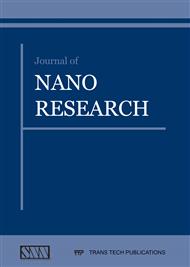[1]
Yi Cui, Z. Zhong, D. Wang, W. U. Wang, C. M. Lieber, High Performance Silicon Nanowire Field Effect Transistors, Nano Lett. 3 (2003) 149−152.
DOI: 10.1021/nl025875l
Google Scholar
[2]
Y. Dong, G. Yu, M. C. Mc Alpine, W. Lu, Charles M. Lieber, Si/a-Si Core/Shell Nanowires as Nonvolatile Crossbar Switches, Nano Lett. 8 (2008) 386-391.
DOI: 10.1021/nl073224p
Google Scholar
[3]
A. I. Hochbaum, R. Chen, R. D. Delgado, W. Liang, E. C. Garnett, M. Najarian, A. Majumdar, P. Yang, Enhanced thermoelectric performance of rough silicon nanowires, NATURE-451 (2008) 163-167.
DOI: 10.1038/nature06381
Google Scholar
[4]
B. Tian, X. Zheng, T. J. Kempa,Y. Fang, N. Yu, G. Yu, J. Huang, C. M. Lieber, Coaxial silicon nanowires as solar cells and nanoelectronic power sources, NATURE 449 (2007) 885-889.
DOI: 10.1038/nature06181
Google Scholar
[5]
J. W. Choi, J. M. Donough, S. Jeong, J. S. Yoo, C. K. Chan, Y. Cui, Stepwise nanopore evolution in one-dimensional nanostructures, Nano Lett. 10 (2010) 1409-1413.
DOI: 10.1021/nl100258p
Google Scholar
[6]
F. Thissandier, A. L. Comte, O. Crosnier, P. Gentile, G. Bidan, E. Hadji, T. Brousse, S. Sadki, Highly doped silicon nanowires based electrodes for micro electrochemical capacitor applications, Electrochemistry Communications 25 (2012) 109–111.
DOI: 10.1016/j.elecom.2012.09.019
Google Scholar
[7]
Nagsen P. Meshram, A. Kumbhar, R.O. Dusane, Silicon nanowire growth on glass substrates using hot wire chemical vapor deposition, Thin Solid Films 519 (2011) 4609–4612.
DOI: 10.1016/j.tsf.2011.01.304
Google Scholar
[8]
S. K. Chong, B. T. Goh, Z. Aspanut, M. R. Muhamad, C. F. Dee, S. A. Rahman, Synthesis of indium-catalyzed Si nanowires by hot-wire chemical vapor deposition, Materials Letters 65 (2011) 2452–2454.
DOI: 10.1016/j.matlet.2011.04.100
Google Scholar
[9]
R. S. Wagner, W. C. Ellis, Vapor-liquid-solid mechanism of single crystal growth, Appl. Phys. Lett. 4 (1964) 89-90.
DOI: 10.1063/1.1753975
Google Scholar
[10]
S. Misra, L. Yu, W. Chen. P. R. i Cabarrocas, Wetting Layer: The Key Player in Plasma-Assisted Silicon Nanowire Growth Mediated by Tin, J. Phys. Chem. C 117 (2013) 17786 −17790.
DOI: 10.1021/jp403063d
Google Scholar
[11]
L. F. Cui, R. Ruffo, C. K. Chan, H. Peng, Y. Cui, Crystalline-Amorphous Core –Shell Silicon Nanowires for High Capacity and High Current Battery Electrodes, Nano Lett. 9 (2009) 491-495.
DOI: 10.1021/nl8036323
Google Scholar
[12]
M. M. Adachi, M. P. Anantram, K. S. Karim, Optical Properties of Crystalline Amorphous Core -Shell Silicon Nanowires, Nano Lett. 10 (2010) 4093–4098.
DOI: 10.1021/nl102183x
Google Scholar
[13]
S. K. Chong, B. T. Goh, Z. Aspanut, M. R. Muhamad, C. F. Dee, S. A. Rahman: Radial growth of slanting-columnar nanocrystalline Si on Si nanowires, Chemical Physics Letters 515 (2011) 68–71.
DOI: 10.1016/j.cplett.2011.08.046
Google Scholar
[14]
A. Soam, N. Arya, A. Kumbhar, and R. Dusane, Controlling the shell microstructure in a low-temperature-grown SiNWs and correlating it to the performance of the SiNWs-based micro-supercapacitor, Applied Nanoscience (2016) 1-7.
DOI: 10.1007/s13204-016-0533-z
Google Scholar
[15]
A. Soam and R. O. Dusane, Charge storage properties of SiNWs grown by hot-wire chemical vapor process technique as electrodes in electrochemical capacitors, International Conference on Advanced Nanomaterials and Emerging Engineering Technologies (2013).
DOI: 10.1109/icanmeet.2013.6609333
Google Scholar
[16]
Y. Y. Wei, G. Eres, V. I. Merkulov, D. H. Lowndes, Effect of catalyst film thickness on carbon nanotube growth by selective area chemical vapor deposition, Applied Physics Letters 78 (2001) 1394-1396.
DOI: 10.1063/1.1354658
Google Scholar


